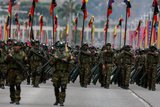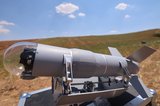IAI adds ASW capability to the maritime Heron (sponsored)
This article is brought to you by IAI.
Addressing the increasing role of unmanned aerial systems (UAS) in maritime operations, Israel Aerospace Industries (IAI) has added new capabilities to the Heron family of UAS, preparing the drone to assume anti-submarine warfare (ASW) missions.
The newly developed anti-submarine warfare capability now includes two new payloads – a Sonobuoy dispensing system for submarine detection anda Magnetic Anomaly Detector (MAD) The combination of the two sensors enable simultaneous detection and tracking of submarines in shallow and deep waters. The use of UAV-mounted ASW capabilities offers significant advantages over conventional, manned aircraft, including longer mision time (dozens of hours on air), persistent monitoring of sonobuoys, and centralized operation of surveillance over very large areas.
This capability employs some of the Heron’s key performance parameters – operations from remote locations; fly long missions at extended range, employing satellite data link, the ability to operate simultaneously with multiple sensors. The ability to operate from a mission control center ashore, or vessels at sea, by handing-off control to a maritime station is another unique function the Heron supports. With these capabilities Heron UAS offers significant benefits over aerial maritime surveillance and ASW patrols, enabling rapid deployment and re-tasking, at a speed of 140 – 220 knots and a much slower loitering speed, at high, low and very low altitude, enabling longer time on station and extended patrol missions. A few teams of operators are tasked in shifts with extended missions, maintaining operators fresh and in optimal performance.
Carrying a full set of sensors – radar, EO and SIGINT, and the new ASW kit requires significant weightlifting, reserved only for large, Medium-Altitude, Long Endurance (MALE) drones such as the Heron. Based on IAI’s Over 40 years of experience as the world pioneer in unmanned aerial systems, the Heron represents IAI’s leading family of UAS, with platforms maximum takeoff weight ranging from 600 to 5,700 kg, capable of lifting payloads from 180 kg to more than a ton.

Image: IAI
IAI was the first UAS manufacturer to deploy drones on maritime surveillance missions, on these missions the Heron carries a combined set of sensors comprising an advanced, lightweight maritime search radar, providing surface search and air/air search capability over hundreds of miles at sea. The radar operates alongside an Electronic Support Measures (ESM), Communications Intelligence (COMINT) and stabilized electro-optical / Infra-red (EO/IR) sensors.
IAI Elta Systems’ ELM-2022U maritime radar provides the primary surveillance sensor on the platform. A lightweight derivative of Elta’s 2022 radar used on board numerous maritime surveillance aircraft worldwide. From a cruising altitude of 20,000 ft. This radar can see across 150 nm to the horizon. The high sensitivity of the radar enables detection and identification of all types of targets encountered at sea, from large vessels classified from a distance using inverse-SAR, to illusive targets having extremely low radar cross-section, such as rubber boats or submarines. ESM and COMINT sensors scan the electromagnetic spectrum to spot suspicious activities indicating the presence of vessels and human activity. Visual observation performed by EO/IR enables operators to identify and verify the identity of vessels and investigate suspicious activities and unidentified targets.
Supporting the anti-submarine mission, the ELM-2022U can spot submarine periscopes and snorkels from a great distance.
Extending its ASW capability, IAI integrated additional sensors including a Magnetic Anomaly Detection (MAD) system and a payload that carries and releases acoustic sonobuoys. After dropping its payload, the Heron loiters over the area to receive and processes the acoustic signal from those sonobuoys, providing a full situational picture based on acoustic, magnetic, radar, SIGINT and visual sensor indications and tracks. This picture is transmitted to a coastal mission control center or a task force at sea, using the Heron’s integral satellite and line-of-sight links.
The Heron gradually evolved to offer a robust, efficient and flexible maritime operation from shore and at sea. Centrally commanded to take off and land from remote shores, Herons extend missions over thousands of kilometers over blue water, using satellite links and handing over control to the operators at sea. Mission control modules are fully integrated onboard naval vessels, including stabilized directional antennas and satellite communications terminals, enabling ships at sea to fully exploit the Heron as part of their sensor suite. With a dedicated mission package and performance unmatched by other MALE UAS, the Heron now supports both maritime and ASW mission capabilities an order of magnitude improved over conventional ASW solutions utilizing fixed and rotary wing manned platforms.
More from Uncrewed Vehicles
-
![What's next for the Pentagon after the Replicator programme?]()
What's next for the Pentagon after the Replicator programme?
Although the Replicator initiative has made several accomplishments, there are still multiple gaps to plug across the US Department of Defense (DoD) and its services.
-
![Cummings Aerospace showcases Hellhound loitering munition designed for US Army’s LASSO programme (video)]()
Cummings Aerospace showcases Hellhound loitering munition designed for US Army’s LASSO programme (video)
Cummings Aerospace presented its turbojet-powered Hellhound loitering munition at SOF Week 2025, offering a man-portable solution aligned with the US Army’s LASSO requirements.
-
![SOF Week 2025: PDW unveils attritable FPV drone for SOF operations at scale]()
SOF Week 2025: PDW unveils attritable FPV drone for SOF operations at scale
PDW has revealed its Attritable Multirotor First Person View drone at SOF Week 2025, offering special operations forces a low-cost, rapidly deployable platform for strike and ISR missions, inspired by battlefield lessons from Ukraine.
-
![SOF Week 2025: Teledyne FLIR white paper provides guidance on reusable loitering munitions]()
SOF Week 2025: Teledyne FLIR white paper provides guidance on reusable loitering munitions
Teledyne FLIR is highlighting the emerging requirements for 'recoverable and re-usable' loitering munitions across the contemporary operating environment during this week’s SOF Week conference in Tampa, Florida.
-
![SOF Week 2025: Kraken Technology group debuts K3 Scout USV in North America]()
SOF Week 2025: Kraken Technology group debuts K3 Scout USV in North America
High-performance maritime industry player Kraken Technology Group, based in the UK, has used the SOF Week conference in Tampa, Florida this week to debut its K3 Scout uncrewed surface vessel (USV) to the North American market.
-
![Palladyne AI and Red Cat to demonstrate capabilities for autonomous drone swarms to the US military]()
Palladyne AI and Red Cat to demonstrate capabilities for autonomous drone swarms to the US military
Red Cat and Palladyne AI recently conducted a cross-platform collaborative flight involving three diverse heterogeneous drones.

























